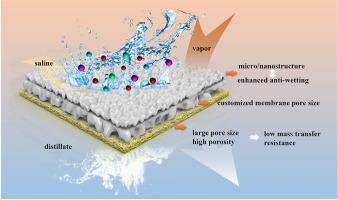Multi-hierarchical structured PTFE membrane for liquid desiccant dewatering via membrane distillation
IF 8.4
1区 工程技术
Q1 ENGINEERING, CHEMICAL
引用次数: 0
Abstract
Poly (tetrafluoroethylene) (PTFE) can be used for robust separation membranes owing to its exceptional chemical and thermal stabilities. Simultaneously achieving construction of hierarchical pore structures and re-entrant surface microstructures during the fabrication of PTFE membrane holds significant importance in addressing the issues of low flux and membrane wetting in membrane distillation (MD). Herein, we proposed a flexible method for manufacturing hierarchically structured PTFE membrane by combining electrospinning/spraying with sintering/welding. The present approach facilitated the controlled fabrication of a superhydrophobic PTFE membrane with slippery surface (exhibiting a water contact angle of 153.5°, and an ultralow sliding angle of 7.5°) without using fluoride-based solvents or external nanoparticles. Moreover, the anti-wetting mechanism and performance stability of the PTFE membranes in MD were thoroughly investigated. In liquid desiccant regeneration experiments, the 20 wt% LiCl solution was successfully concentrated to 28.64 wt%. Furthermore, the PTFE membrane demonstrated a stable flux (>30 kg m−2 h−1) and relatively low permeate conductivity (<15 μs cm−1) during treating simulated seawater for 30 h. The present work offers a new approach to fabricate multi-hierarchical structured superhydrophobic membranes for desalination and regeneration of liquid desiccants.

通过膜蒸馏进行液体干燥剂脱水的多层结构聚四氟乙烯膜
聚四氟乙烯(PTFE)具有优异的化学和热稳定性,可用于制造坚固的分离膜。在制造聚四氟乙烯膜的过程中,同时构建分层孔隙结构和重入式表面微结构对于解决膜蒸馏(MD)中的低通量和膜润湿问题具有重要意义。在此,我们提出了一种结合电纺丝/喷射和烧结/焊接的灵活方法来制造分层结构的聚四氟乙烯膜。该方法无需使用含氟溶剂或外部纳米粒子,即可控制制造出表面光滑的超疏水聚四氟乙烯膜(水接触角为 153.5°,超低滑动角为 7.5°)。此外,还深入研究了聚四氟乙烯膜在 MD 中的防湿机制和性能稳定性。在液体干燥剂再生实验中,20 wt% 的氯化锂溶液成功浓缩至 28.64 wt%。此外,在处理模拟海水 30 小时的过程中,聚四氟乙烯膜表现出了稳定的通量(30 kg m-2 h-1)和相对较低的渗透电导率(15 μs cm-1)。 本研究为制造用于脱盐和液体干燥剂再生的多层结构超疏水膜提供了一种新方法。
本文章由计算机程序翻译,如有差异,请以英文原文为准。
求助全文
约1分钟内获得全文
求助全文
来源期刊

Journal of Membrane Science
工程技术-高分子科学
CiteScore
17.10
自引率
17.90%
发文量
1031
审稿时长
2.5 months
期刊介绍:
The Journal of Membrane Science is a publication that focuses on membrane systems and is aimed at academic and industrial chemists, chemical engineers, materials scientists, and membranologists. It publishes original research and reviews on various aspects of membrane transport, membrane formation/structure, fouling, module/process design, and processes/applications. The journal primarily focuses on the structure, function, and performance of non-biological membranes but also includes papers that relate to biological membranes. The Journal of Membrane Science publishes Full Text Papers, State-of-the-Art Reviews, Letters to the Editor, and Perspectives.
 求助内容:
求助内容: 应助结果提醒方式:
应助结果提醒方式:


